Ever wondered about the stories behind the faces depicted on
Indonesian currency?
In this article, we will explore the narratives behind the
figures, cultural festivities, and breath-taking natural wonders featured on
the banknotes frequently exchanged in Bali!

On September 5, 2016, the Bank of Indonesia introduced new
banknotes adorned with portraits of national heroes. These banknotes depict
significant figures from Indonesian history, including individuals who played
pivotal roles in the country's struggle for independence and development.
The back side of the new banknotes introduced by the Bank of
Indonesia showcase various cultural and natural landmarks from different
regions of Indonesia. These include scenes such as traditional dances, iconic
landscapes, and significant natural wonders, providing a glimpse into the rich
cultural diversity and natural beauty of the Indonesian archipelago.
1,000 Rupiah
Front: Cut Nyak Meutia
Back: The Tifa
Dance from the Irian Jaya province; Banda
Neira island in the Maluku province
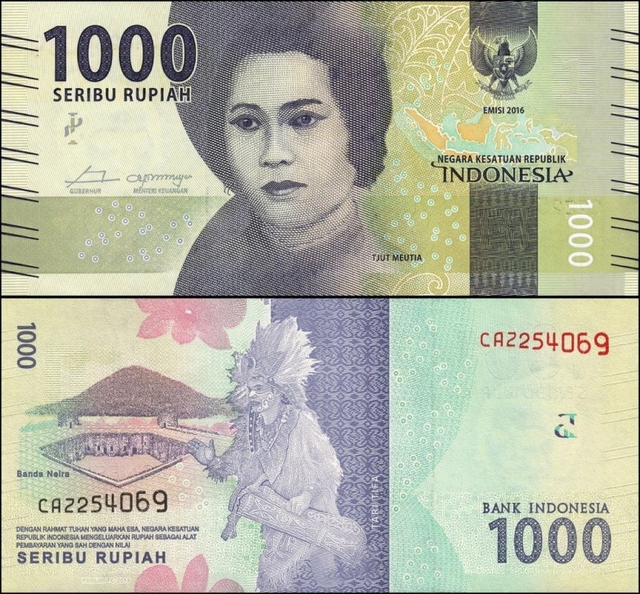
Cut Nyak Meutia (1870 – 1910) was a courageous
Indonesian woman who played a pivotal role in the struggle for independence
against Dutch colonial rule. Born in Aceh, she became a prominent figure in the
resistance movement, fighting fiercely against Dutch forces. Following the death of her third husband in battle, Cut Nyak Meutia took charge, leading a troop of 45 fighters armed with 13 cannons. In a tragic turn of events, she was ultimately captured and killed by Dutch forces in 1910. Her bravery and leadership have made her a revered symbol of Indonesian nationalism and the fight for independence.
The Tifa Dance originates from Irian Jaya in
Indonesia, holding cultural significance for indigenous communities. It
features lively movements and percussion accompaniment, with dancers adorned in
traditional attire. Beyond entertainment, the dance preserves and celebrates
the cultural heritage of these regions, showcasing Indonesia's diverse
traditions.
Banda Neira, situated in Indonesia's Maluku province,
is a historically significant island once renowned for its role in the spice
trade. Its colonial-era architecture and nutmeg plantations reflect its rich
past. Today, visitors can explore its picturesque streets, forts, and churches,
and enjoy its tranquil ambiance. The island also offers excellent opportunities
for snorkelling and diving amidst vibrant coral reefs and marine life. Despite
its remote location, Banda Neira has become a popular destination for travellers
seeking off-the-beaten-path experiences in Indonesia.
2,000 Rupiah
Front: Mohammad Husni Thamrin
Back: The
Piring Dance of the Minangkabau people in West Sumatra; Sianok
Canyon in West Sumatra
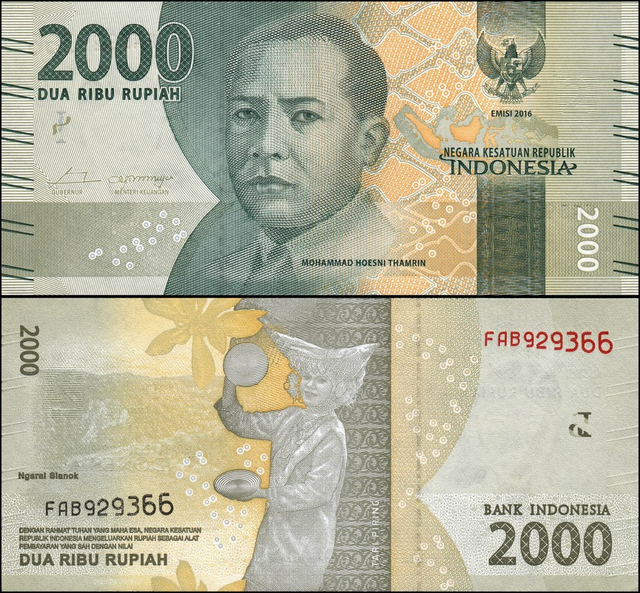
Mohammad Husni Thamrin (1894 – 1941) was a prominent
Indonesian nationalist leader who dedicated his life to the struggle for
independence from Dutch colonial rule. He played a pivotal role in unifying
nationalist movements across Indonesia and advocated for the adoption of the
name "Indonesia" for the nation. Despite facing opposition and
suspicion from colonial authorities, Thamrin remained steadfast in his
commitment to the cause of Indonesian independence until his untimely death
while under house arrest in 1941. His legacy as a champion of national unity
and sovereignty continues to inspire Indonesians today.
The Piring Dance, originating from the
Minangkabau ethnic group in West Sumatra, Indonesia, is a traditional cultural
performance where dancers balance plates (piring in Indonesian) in each
hand while executing graceful choreography. Accompanied by traditional
Minangkabau music featuring lively rhythms and melodious tunes played on
instruments like the talempong and talempong tuku, the dance
showcases intricate plate balancing skills and reflects the community's values
and traditions. Often performed at cultural events and festivals, the Piring
Dance celebrates the rich cultural heritage of West Sumatra and Indonesia.
Sianok Canyon, located in West Sumatra,
Indonesia, is a captivating natural wonder renowned for its stunning landscapes
and geological formations. Stretching approximately 15 kilometres with cliffs
reaching up to 100 meters in height, the canyon offers breath-taking views of
limestone cliffs adorned with lush greenery, and the winding Sianok River
below. Visitors can explore the area through hiking trails or guided tours to
vantage points like Panorama Park and Puncak Lawang. Apart from its natural
beauty, Sianok Canyon is culturally significant, situated near Bukittinggi, a
historic city known for its Minangkabau architecture and vibrant markets.
Sianok Canyon provides an immersive experience in Indonesia's natural beauty
and rich heritage, making it a must-visit destination for nature enthusiasts
and adventurers.
5,000 Rupiah
Front: Idham Chalid
Back: Gambyong
Dance from Surakarta city in Central Java; Mount
Bromo in Java
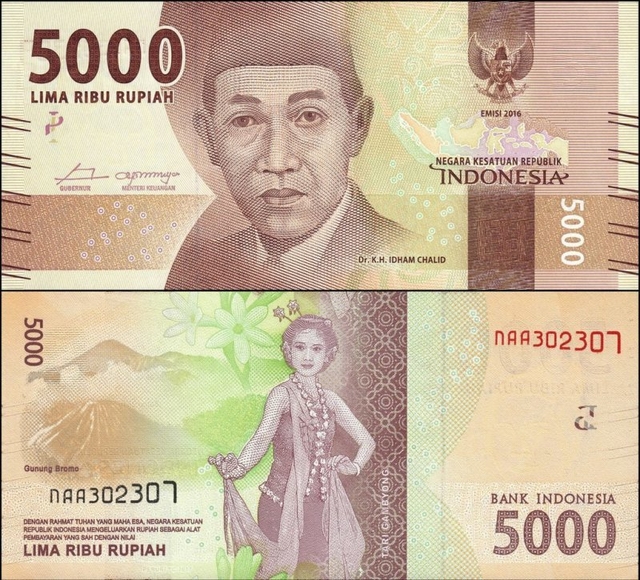
Idham Chalid (1921 – 2010) was a prominent Indonesian
statesman who held key government positions, including Deputy Prime Minister
and Coordination Minister for People's Welfare Affairs. Known for his
dedication to public service, Chalid focused on policies to enhance the welfare
of Indonesians and address socio-economic challenges. His legacy reflects his
commitment to national development and governance, earning him respect in
Indonesian politics.
The Gambyong Dance is a traditional Javanese dance
originating from Surakarta (Solo), Central Java, Indonesia. It features
graceful movements performed by female dancers, adorned in traditional Javanese
attire, accompanied by a gamelan ensemble. Often showcased at cultural events
and ceremonies, the dance symbolizes Javanese cultural heritage and continues
to captivate audiences with its elegance and beauty.
Mount Bromo is an iconic active volcano located in
East Java, Indonesia. It is renowned for its stunning landscape, featuring a
vast caldera surrounded by a "sea of sand." Visitors flock to Mount
Bromo to witness the spectacular sunrise over the volcanic terrain and to hike
to the rim of the crater for a close-up view of its active volcanic activity. The
surrounding Bromo Tengger Semeru National Park offers opportunities for
adventure and exploration, including hiking trails and visits to nearby
villages. Overall, Mount Bromo is a must-visit destination for travellers
seeking natural beauty and adventure in Indonesia.
10,000 Rupiah
Front: Frans Kaisiepo
Back: The Parakena
Dance from South Sulawesi; Wakatobi
National Park
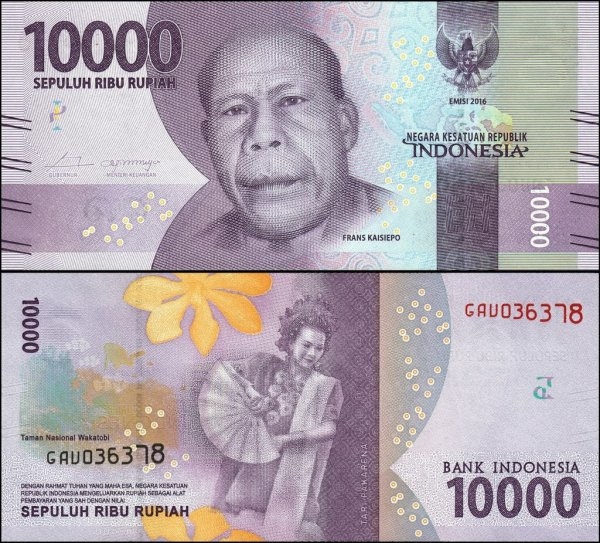
Frans Kaisiepo (1921 – 1979) was a pivotal figure in
Papua's history, serving as its fourth governor from 1964 to 1973. Born in
Biak, he tirelessly advocated for Papua's integration into Indonesia, proposing
the name "Irian" during a critical conference in 1946. Despite facing
opposition and enduring imprisonment, Kaisiepo remained steadfast in his commitment
to unity and development in Papua. His efforts earned him recognition as a
national hero, inspiring peace, and unity in the region and across Indonesia.
The Parakena Dance hails from South Sulawesi,
Indonesia, and is cherished by the Bugis and Makassar ethnic groups. Known for
its energetic moves and vibrant costumes, it captivates audiences during
cultural festivities and celebrations. Through its spirited performance, the
dance honours the cultural heritage of South Sulawesi, showcasing traditions
and beliefs with dynamic choreography and lively music. It stands as a vibrant
expression of local identity and pride, celebrating the rich diversity of
Indonesian culture.
Wakatobi National Park is a marine conservation area
located in Southeast Sulawesi, Indonesia. It is renowned for its rich
biodiversity and pristine coral reefs, making it a paradise for snorkelers and
divers. The park encompasses a group of four main islands: Wangi-Wangi,
Kaledupa, Tomia, and Binongko, which together form the acronym
"Wakatobi." Visitors to Wakatobi National Park can explore its
crystal-clear waters teeming with colourful coral formations, tropical fish,
and other marine life. The park is also home to various endangered species,
including sea turtles and rare fish species. In addition to its underwater
attractions, Wakatobi offers opportunities for eco-tourism, cultural
experiences, and relaxation on its picturesque beaches. With its stunning
natural beauty and commitment to conservation, Wakatobi National Park is a
must-visit destination for nature lovers and adventure seekers in Indonesia.
20,000 Rupiah
Front: Sam Ratulangi
Back: The Gong
Dance of the Dayak tribe from East Kalimantan; Derawan
Island of East Kalimantan
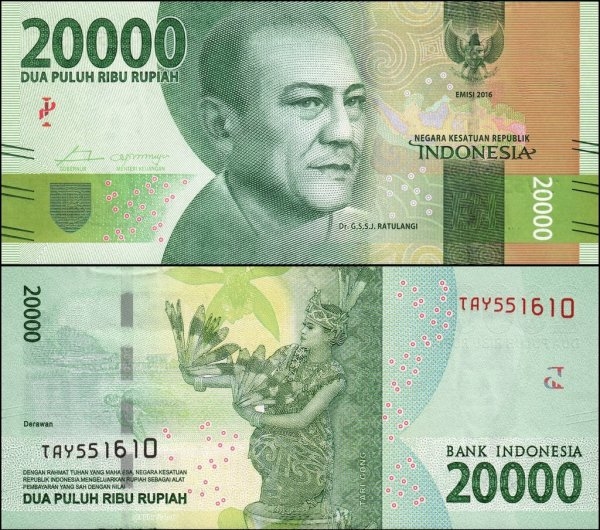
Sam Ratulangi (1890 – 1949) was a prominent figure in
the Indonesian independence movement, hailing from North Sulawesi. As a leader
and intellectual, he championed the cause of Indonesian independence from Dutch
colonial rule. Ratulangi's contributions include founding an insurance company
using the term "Indonesia" for the first time, advocating for justice
and reforms in North Sulawesi, and authoring the prophetic book "Indonesia
in the Pacific," which warned against Japan's militarization. He
fearlessly opposed colonial rule and played a crucial role in Indonesia's path
to independence, serving as the first governor of Sulawesi. Despite facing
imprisonment and exile by the Dutch, Ratulangi's legacy as a national hero
lives on, inspiring generations with his courage and dedication to freedom and
justice.
The Gong Dance is a traditional performance
originating from the Dayak tribe of Borneo, Indonesia. It features rhythmic
beats from large gongs, synchronized movements, and symbolic props. Often
performed during festivals and ceremonies, this dance reflects the Dayak
people's deep connection to nature and ancestral traditions. It serves as a way
to preserve their rich cultural heritage and unite the community. With its
captivating music and graceful movements, the Gong Dance showcases the spirit
and vitality of Dayak culture.
Derawan Island, situated in East Kalimantan, Indonesia,
is renowned for its pristine white sandy beaches, clear turquoise waters, and
vibrant coral reefs. It's part of the Derawan Archipelago, offering world-class
snorkelling and diving experiences amidst diverse marine life. Visitors can
also enjoy leisure activities like beach relaxation and island hopping, as well
as unique attractions like Kakaban's jellyfish lake. With its breath-taking
beauty and rich biodiversity, Derawan Island is a paradise for nature lovers
and adventure seekers alike.
50,000 Rupiah
Front: Djuanda Kartawidjaja
Back: The Balinese
Legong Dance; Komodo
National Park
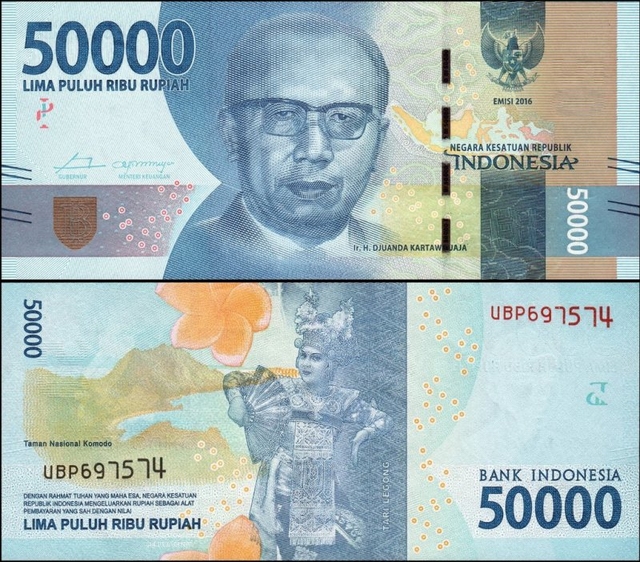
Djuanda Kartawidjaja (1911 – 1963) was a prominent
Indonesian statesman who held key ministerial positions in the government during
the nation's early years of independence. He served as Minister of
Transportation, Public Works, Defence, and Finance, contributing significantly
to the development of Indonesia's infrastructure, economy, and governance.
Kartawidjaja's dedication to public service and his efforts to advance the
country's interests continue to be remembered as part of his enduring legacy.
The Balinese Legong Dance is a captivating
traditional art form originating from Bali, Indonesia. It features graceful
movements, intricate choreography, and young female dancers trained from a
tender age. Accompanied by the mesmerizing sounds of a gamelan orchestra, the
dance depicts scenes from Hindu epics and Balinese folklore. Through its
storytelling and symbolism, the Legong Dance celebrates Balinese culture,
spirituality, and artistic prowess. Today, it continues to enchant audiences at
temples, palaces, and cultural events, preserving Bali's rich heritage for
generations to come.
Komodo National Park is a UNESCO World Heritage Site
located in Indonesia, encompassing several islands, including Komodo, Rinca,
and Padar. The park is famous for being the natural habitat of the Komodo
dragon, the world's largest lizard species. In addition to the Komodo dragon,
the park boasts diverse marine life, stunning landscapes, and pristine beaches.
Visitors can embark on guided tours to see the Komodo dragons in their natural
habitat, hike to panoramic viewpoints, snorkel, or dive in crystal-clear
waters, and explore the park's rich biodiversity. With its unique wildlife and breath-taking
scenery, Komodo National Park is a must-visit destination for nature
enthusiasts and adventure seekers in Indonesia.
100,000 Rupiah
Front: Sukarno and Mohammad Hatta
Back: The Betawi
Topeng Dance of the Betawi tribe from Jakarta; Raja
Ampat Archipelago
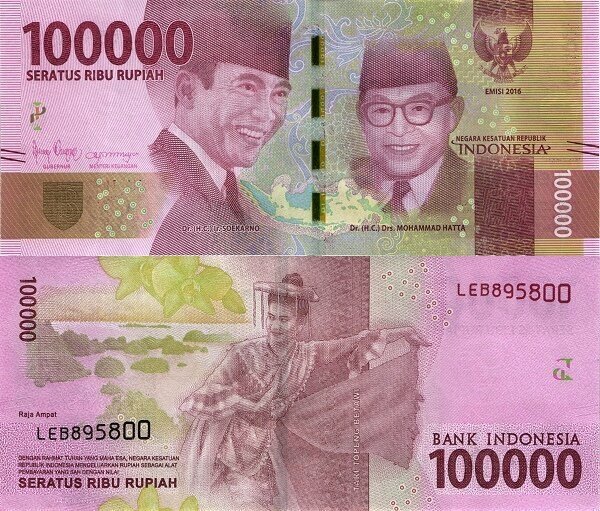
Sukarno (1901 – 1970) was the inaugural President of
Indonesia, leading the nation from 1945 to 1967. He played a vital role in
securing Indonesia's independence from Dutch colonial rule and was known for
his ability to unite diverse communities. Sukarno introduced "Guided
Democracy" in 1959 to stabilize the country, but his presidency saw a shift
towards leftist alliances with communist nations. However, his tenure ended
abruptly in 1967 due to a military coup led by General Suharto. Despite his
controversial legacy, Sukarno remains a revered figure in Indonesian history
for his pivotal role in the nation's early years of independence.
Mohammad Hatta (1902 – 1980) was a prominent
Indonesian nationalist leader who played a crucial role in the country's
struggle for independence alongside Sukarno. Serving as Indonesia's first Vice
President after independence, Hatta was known for his diplomatic skills,
advocacy for economic development, and commitment to democratic principles. His
legacy as a founding father of Indonesia is celebrated for his dedication to
independence, democracy, and social justice, as well as his efforts in
nation-building.
The Betawi Topeng Dance is a traditional art form
originating from the Betawi ethnic group in Jakarta, Indonesia. It features
performers wearing elaborate masks, depicting characters from Betawi folklore
and mythology. This dance form is often showcased at cultural festivals and
weddings, combining storytelling, music, and dance. Each mask represents a
specific character, with dancers skilfully portraying them through movements
and expressions. Accompanied by traditional Betawi music, including drums and
xylophones, the dance serves as a celebration of Betawi cultural heritage,
preserving their unique identity and traditions for future generations.
Raja Ampat archipelago in Indonesia's West Papua province is renowned
for its stunning natural beauty, vibrant marine life, and pristine beaches.
With its biodiverse marine environment, including colourful coral reefs and
rare species like whale sharks, it's a paradise for snorkelers and divers.
Island hopping allows visitors to explore hidden coves and scenic viewpoints,
while cultural experiences offer insights into indigenous Papuan traditions.
Conservation efforts ensure the preservation of its unique
ecosystem, making Raja Ampat a must-visit destination for nature lovers and
adventurers.
As we conclude our journey through the stories behind
Indonesian currency, we are reminded of the rich history, culture, and natural
beauty that defines the nation. From the heroic figures who fought for
independence to the vibrant celebrations and majestic landscapes depicted on
banknotes, each element symbolizes Indonesia's diverse and enduring spirit. As
these currencies continue to exchange hands in Indonesia, may they serve as a
constant reminder of the remarkable journey and heritage of the Indonesian
people.
You can add one right now!